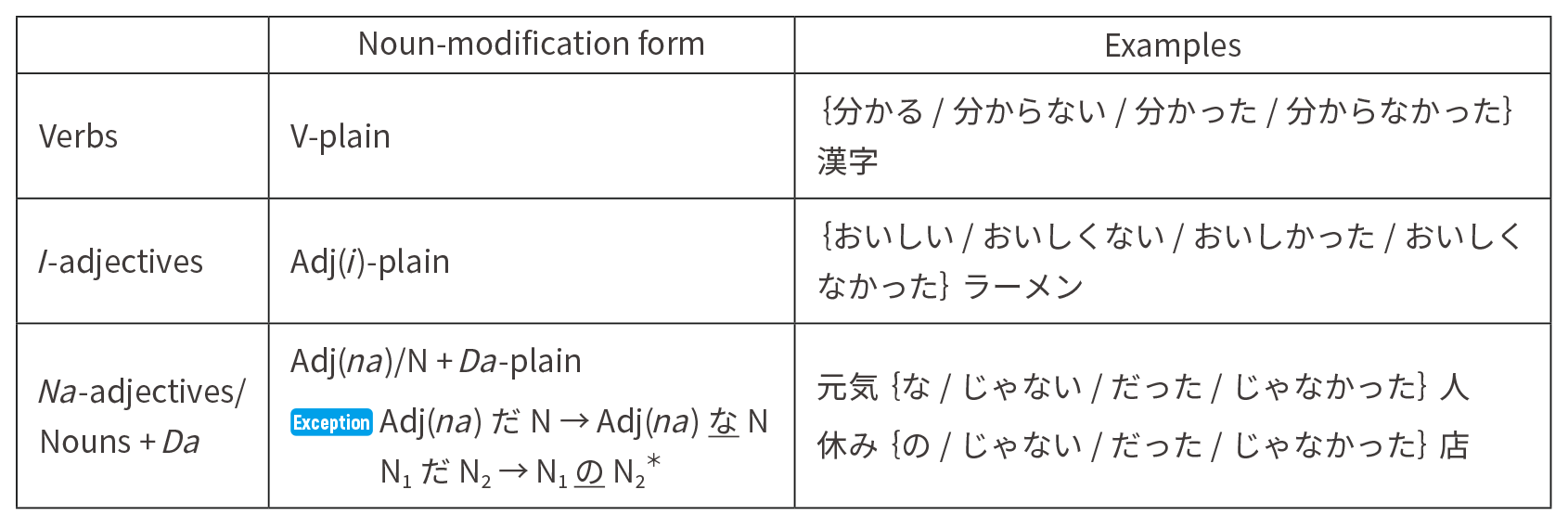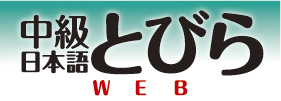言語ノート:Noun modification structures Grammar Note
Structures in which nouns are modified by elements that specify or explain their referents are called “noun modification structures” (NMSs). In Japanese, there are several types of noun modification structures. (1) shows the simplest ones:
(1) a. 新しい車 [I-adjective + Noun]
b. 便利なアプリ [Na-adjective + な + Noun]
c. 日本の名所 [Noun + の + Noun]
d. この学生 [Demonstrative adjective + Noun]
By combining noun-modifying elements as seen in (1), more complex NMSs can be formed, as shown in (2):
(2) a. 安くておいしい食べ物
b. 私の大学のカフェテリアのコーヒー
c. あの有名な歌手の歌
Another common NMS is one in which a clause modifies a noun, as in (3). (The underlined portions are the noun-modifying clauses, and the nouns being modified are enclosed in boxes.)
(3) a. 私達が使っている教科書 (the textbook(s) that we are using)
b. 日本に留学した学生 (students who went to Japan to study)
c. 家賃が安いアパート (a low rent apartment (lit. an apartment whose rent is low))
d. 料理が上手な人 (people who are good at cooking)
e. お父さんが医者の友達 (a friend whose father is a doctor)
NMSs like those in (3) are often referred to as “relative clause structures,” and the clauses that modify the nouns are called “relative clauses.” By using the relative clause structure, things, people, places, etc. can be described in a more concise fashion than otherwise, which makes communication easier and more efficient.
There are several key rules for relative clauses in Japanese:
[A] Relative clauses always come before the nouns they modify.
[B] Japanese does not use relative pronouns like that, who or which.
[C] The topic marker は is not used inside relative clauses, as in (4).
(4) 先週、私は日本に留学した学生と話した。
(Last week I talked with a student who went to Japan to study.
(私は is not part of the relative clause.))
[D] If the subject appears in a relative clause, it is usually marked with が, as in (3a).
[E] の can be used instead of が in relative clauses, as in (5).
(5) a. 私達の使っている教科書 (=(3a))
b. 料理の上手な人 (=(3d))
[F] The final elements of relative clauses (i.e., the parts directly before the modified nouns) must be in the noun-modifying forms. Those of verbs and i-adjectives are the same as their plain forms. (6) summarizes the noun-modifying forms for verbs, i-adjectives and na-adjectives/nouns+Da :
(6)
*Some N2 require である instead of の. (Exs. 仕事が夜である点;彼がリーダーであるおかげ)
In reading Japanese sentences, identifying noun modification portions, including relative clauses, is essential because accurate comprehension cannot be obtained otherwise. The rules above are to help with that.
《 Exercises 》
Underline the relative clauses that modify the boxed nouns below:
a. 留学していた時、家賃の安い寮に住んでいました。
b. この店より私がよく行く店の方がおいしいと思います。
c. これは、誕生日に絵が上手な友達にもらったスケッチです。
d. 昔、母がフランスで買って、私にくれたネックレスを今も大切に使っています。
References
1. 『初級日本語 とびら II 』L.11 文法 2. Noun modification clauses
(This section explains relative clauses in detail.)
2. Grammar in Depth (Part 2) E-3. Noun modification clauses
(This section overviews various types of noun modification structures.)


